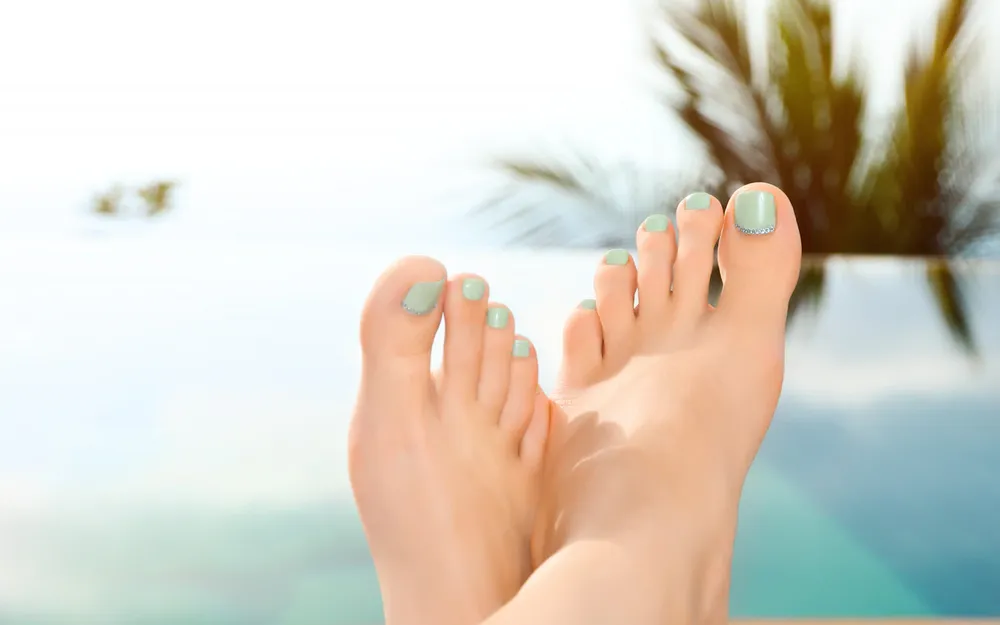📑 The BeautyBar Journal
Here’s where we share a little extra love about expert nail, skin, and self-care tips.

Foot Reflexology & Pedicures: The Wellness Connection
Have you ever wondered why a simple foot massage can leave you feeling completely rejuvenated? There’s more to it than just relaxation. The effect of foot reflexology and therapeutic pedicures reaches far beyond your feet, it also impacts your overall well-being in measurable ways.
Understanding the link between reflexology treatments and the increasingly popular therapeutic pedicures, you can unlock a deeper level of wellness. In this article, we’ll explore how these two practices intersect and how combining them may enhance both your beauty and health outcomes.
Understanding Foot Reflexology
Foot reflexology is an ancient therapeutic massage technique that involves applying pressure to reflex points located primarily on the soles of the feet. This practice has roots in Traditional Chinese Medicine (TCM) and ancient Egyptian and Indian medical traditions. The underlying belief is that these points correspond with every area of the body, including internal organs, glands, and systems.
Reflexology is guided by a foot reflexology chart, which maps out these reflex points. For example, pressure applied to the arch of the foot may influence digestive function, while pressing certain points on the feet may target the sinuses or lower back. This process aims to stimulate the nervous system, improving the flow of energy (Qi), enhancing circulation, and promoting relaxation.

Source: https://www.healthline.com/health/foot-reflexology-chart
Modern techniques involve applying pressure with thumbs, fingers, and knuckles using systematic motions. A typical reflexology session may last from 20 to 60 minutes, during which a trained reflexologist will focus on specific points associated with the client’s symptoms or health goals.
Reflexology goes beyond a gentle foot rub—it’s a therapeutic practice with growing clinical evidence supporting its role in stress relief and symptom management.
The Art and Science of Pedicures

You might associate pedicures with cosmetic beauty, but the truth is, this age-old practice has evolved into a legitimate form of therapeutic self-care. Originating from ancient civilizations, including Egypt and Rome, pedicures were once reserved for the elite. Today, they are accessible wellness rituals enjoyed by people from all walks of life.
A standard pedicure includes cleansing, exfoliating, moisturizing, trimming, and shaping the toenails. However, its modern iteration can go far beyond pampering. As pedicure practices have advanced, they now often include massage therapy techniques, foot reflexology massage, and even aromatherapy, turning the treatment into a full-blown holistic experience.
What’s notable is the increasing shift in pedicures from being purely aesthetic to becoming a part of an alternative medicine regimen. Many spas and medical pedicure services now integrate clinical techniques, ensuring clients receive both health and beauty benefits in one session.
Health Benefits of Reflexology
The most well-documented benefit of reflexology is its powerful role in stress reduction and relaxation. As noted by Healthline and WebMD, stimulating points in the feet helps calm the nervous system, slow the heart rate, and lower cortisol levels. Clients often report a profound sense of calm after a 20-minute foot reflexology treatment.
Beyond mental well-being, reflexology may help reduce pain in various contexts. Numerous randomized controlled trials have demonstrated the effect of reflexology on pain intensity in patients undergoing procedures like coronary artery bypass graft surgery and even cancer treatment. For instance, one reflexology trial found that foot reflexology significantly reduced both pain and anxiety compared to control groups.
Additionally, reflexology massage can boost circulation, helping oxygen and nutrients reach tissues more efficiently. Improved blood flow positively impacts skin tone, organ function, and even energy levels. Specific reflexology techniques have also been used to manage digestive issues, eyestrain, and sleep disturbances—offering a comprehensive tool for natural healing.
Therapeutic Advantages of Regular Pedicures
Routine pedicures do more than maintain appearance, they also actively contribute to preventing infections by removing dead skin, calluses, and bacteria-prone buildup around the toenails. This reduces your risk of developing conditions like fungal infections, ingrown nails, and athlete’s foot.
One often overlooked benefit is the ability to detect underlying issues early. Trained professionals can spot signs of bunions, warts, or other skin anomalies before they worsen. For clients with conditions like diabetes, this can be lifesaving.
Furthermore, the exfoliation and moisturization involved in pedicures improve the health and texture of the feet, preventing cracks and dryness that can become painful or infected. Some spas incorporate therapeutic massage into their pedicures, which promotes healthy blood circulation—aiding in cellular repair and reducing inflammation.
Don’t underestimate the emotional benefits either. Research suggests that grooming rituals, such as pedicures, can play a role in reducing stress and enhancing emotional well-being.
Integrating Reflexology into Pedicure Treatments

Combining foot reflexology with a pedicure is like pairing nutrition with exercise—it amplifies the effect. Many salons now offer reflexology pedicures, where a reflexologist or trained technician incorporates pressure point therapy into the massage portion of the pedicure.
This approach allows you to experience the relaxing and aesthetic perks of a pedicure while tapping into the deeper health benefits of reflexology treatment. When pressure is applied to specific reflex points, it can stimulate corresponding areas of your foot tied to internal organs and bodily functions.
The Role of Medical Pedicures
Medical pedicures, or “medi-pedis,” are performed by specially trained professionals often in clinical or spa-medical hybrid settings. Unlike traditional pedicures, these are designed specifically to address underlying foot health conditions, not just cosmetic upkeep.
Medical pedicures are ideal for individuals with diabetes, poor circulation, or autoimmune conditions. These treatments adhere to sterile techniques, using autoclaved tools and clinical-grade products to minimize infection risks. This makes them especially important for those who may not be good candidates for standard spa pedicures due to compromised immunity or skin integrity.
The key distinction is that medical pedicures prioritize prevention and treatment, often detecting and addressing issues before they escalate into serious complications. Many also incorporate reflexology to complement the physical care with stress-reducing techniques.
Choosing the Right Practitioner
Whether you're seeking a reflexology session or a pedicure, choosing a qualified practitioner is crucial. Look for credentials from respected organizations, such as the American Reflexology Certification Board, and inquire about their training and experience.
Before committing to a treatment, ask:
Is the practitioner certified in reflexology techniques?
What sanitation methods are used?
Do they tailor treatments for specific conditions or sensitivities?
Also, inspect the environment. A reputable provider will maintain clean stations, sterilized tools, and transparent protocols. Prioritizing your safety and comfort is non-negotiable in today’s best current practices.
At-Home Foot Care Practices
Between appointments, you can care for your feet with simple reflexology techniques and basic pedicure routines at home. Start by soaking your feet in warm water with Epsom salts, then exfoliate gently with a pumice stone.
Use a foot reflexology chart to locate reflexology points and apply pressure with your thumbs or a massage tool to areas associated with your personal health concerns. Even 10 minutes a day can provide stress relief and increase circulation.
Invest in quality tools like cuticle pushers, nail files, and a good foot cream to keep your skin soft and nails tidy. Regular moisturization is essential for preventing cracks and dryness, especially during colder months.
Experience Wellness at BeautyBar SGV

At BeautyBar in San Gabriel Valley, we believe foot care is more than a beauty ritual, it’s a powerful form of wellness. That’s why we’ve designed our pedicure services to go beyond polish and pampering. By thoughtfully integrating reflexology techniques into our treatments, we help soothe your stress, support circulation, and restore balance from the ground up. Whether you’re seeking relaxation, relief, or a touch of indulgence, our spa is a sanctuary where your feet and your well-being come first.
Frequently Asked Questions (FAQs)
1. What is the difference between foot reflexology and a regular foot massage?
A regular foot massage relaxes muscles and stimulates blood flow. Foot reflexology, on the other hand, involves applying pressure to specific reflex points that correspond to different parts of the body, aiming to improve overall health.
2. How often should one get a pedicure for optimal foot health?
Every 4–6 weeks is ideal, but those with specific conditions may benefit from more frequent reflexology sessions or medical pedicures.
3. Are there any contraindications for foot reflexology?
Yes. Individuals with open wounds, infections, blood clots, or certain heart conditions should consult their physician before receiving reflexology treatment.
4. Can individuals with diabetes safely receive pedicures and reflexology treatments?
Yes—but only from qualified professionals trained in medical pedicures who understand how to work with diabetic clients.
5. Is it possible to perform effective reflexology on oneself at home?
Yes! With a foot reflexology chart and proper technique, you can target reflex points to relieve pain, reduce stress, and support overall wellness.
Conclusion
Foot reflexology and pedicures are more than just indulgent spa activities, they’re evidence-based wellness practices that support your health from the ground up. By revisiting reflexology as a form of alternative medicine and integrating it with modern foot care, you can enjoy enhanced physical and emotional well-being.
If you’re ready to explore the many potential benefits of reflexology, relieve stress, and reduce pain, consider trying a reflexology massage during your next pedicure appointment. Your feet and the rest of your body will thank you.
At BeautyBar SGV, we’re proud to offer expert-level reflexology and foot care services tailored to your needs. Book your next session today and step into a healthier you.


